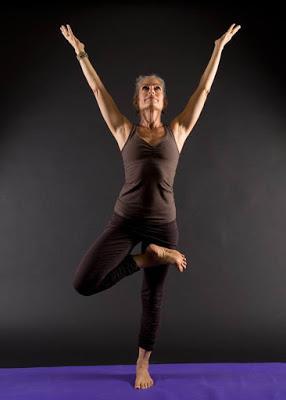
Joy Sassoon, Age 60
Q: A number of us here in VA are curious about the specific rationale for the balance sequences Baxter shared with us and is sharing with the world on a weekly basis - being first static and then dynamic. I've read Baxter's articles from the dates below and understand that “the main goal of balance training is to continually increase your client’s awareness of his or her balance threshold or limits of stability by creating controlled instability.” .... (Dec 17, 2014, Jan 26, 2015, Mar 3, 2015) ... but am curious what the underlying principles/theories for first holding a pose and then moving dynamically between a couple or more poses.Is it the "work" the body is doing while static that is helpful (the nervous system, eyes, vestibular system, etc.) in finding balance moment to moment before challenging ourselves with movement into and out of a set of poses? From Mr. Desikachar (and others) the "dynamic then static" model has been so engrained here. Of course there may be other reasons to practice "static then dynamic"; a number of us here are curious specifically how this works for keeping and improving balance.
A: This is a great question, and one I tried to highlight in my post News on Balance, Falling, and Yoga on integrating new concepts on improving balance a while back. And the reader is correct that I am recommending a different sequencing approach to the order dynamic mini-vinyasa to static asana that TKV Desikachar recommends in his book The Heart of Yoga. Before I get why I recommend my to doing a static balance pose first, followed by a dynamic mini-vinyasa version, let’s look at what Desikachar has to say about his recommendations:
“There are 2 ways of practicing asana: The dynamic practice repeats the movement into the asana and out again in rhythm with the breath. In static practice we move into an out of the pose in the same way as with the dynamic practice, but instead of staying in continual movement with the breath, we hold the pose for a certain number of breath cycles [with a certain chosen focus]. Dynamic movements allow the body to get used to the position gently and gradually. For this reason it is always better to practice an asana dynamically first, before attempting to hold it.
“A dynamic performance of asanas therefore not only helps to prepare for difficult static postures but also intensifies the practice of a particular asana or gives it special direction.”
And for quite awhile now I have been practicing and teaching in this way, and finding it useful and generally appropriate. Then I came across this article Integrated Balance Training by the National Academy of Sports Medicine, with their modern recommendations about improving balance specifically. (Although technical in some places, I highly recommend teachers out there to try diving into this paper.) And I am so interested in learning as much as I can about improving balance and helping my students to reduce their risk of falls over time, that I was intrigued to see what they had to add to my understanding.
In this paper, the authors recommend a practical set of steps for a given exercise session: the exercises progress from slow to fast, simple to complex, known to unknown, low force to high force, static to dynamic, two arms to one arm, two legs to one leg, stable to unstable, eyes open to eyes closed, and, most importantly, quality before quantity. Their recommendations utilize a particular training model called the Optimum Performance Training (OPT) model. The program includes three distinct phases:
- Level 1: Stabilization
- Level 2: Strength
- Level 3: Power
So, in making these suggestions to you and using these techniques in my balance videos, I am attempting to meld some modern sports medicine concepts around improving balance with some longer standing sequencing guidelines from the yoga tradition. If I were you, I would utilize the dynamic to static recommendations when designing a balanced asana class, and if I were going to focus on a few balance poses or practices, I would then utilize the static to dynamic option recommended by the NASM for those specific poses within my sequence. And, of course, I would track the results of these sequencing choices for over time. And if the static to dynamic approach to balancing poses proves helpful for improving functional balance (both static situations and real life dynamic situations), I’d consider using that approach for balance poses as part of my sequencing options.
—Baxter
Subscribe to Yoga for Healthy Aging by Email ° Follow Yoga for Healthy Aging on Facebook ° Join this site with Google Friend Connect

